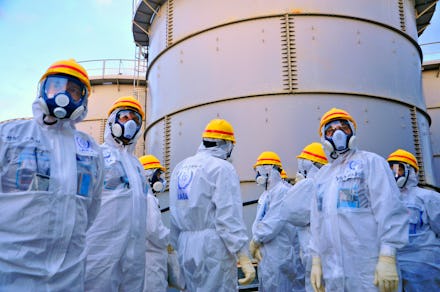Fukushima Workers Have Embarked on a Huge Project Right Out of 'Game of Thrones'

The news: Japanese construction crews in Okuma, Japan, just started work on a massive underground ice wall to rival the snow-capped North Wall in the Game of Thrones. The barrier is designed to prevent radioactive water leakage from the Fukushima Daiichi nuclear reactor, which failed in 2011 after being hit by a tsunami. The one-mile, $300 million setup is composed of 1,550 coolant-circulating pipes that would theoretically freeze the soil around them. The resulting wall of ice would prevent clean groundwater nearby from seeping under the plant and mixing with its toxic sludge.
Will this plan work? Unlike the North Wall, this barrier is being built without the aid of magic. As a result, it has a few problems. Keeping the ground frozen in a place with summers that spike to an average of 86 degrees Fahrenheit could prove tricky. In addition, Tepco, the Japanese power company that owns the plant, hasn't yet outlined its plans for storing all of the water the wall's pipes would require. Last year, the company admitted the plant was already leaking 300 tons of radioactive water into the sea each day because they lacked the space, planning and equipment to store it.
Is leaking radiation a real concern? In February 2014, scientists at the annual Ocean Sciences Meeting of the American Geophysical Union in Honolulu announced that radioactive ocean water from the 2011 Fukushima disaster had finally reached North America's western coast. Fortunately for us, the radioactive elements had been so diluted by ocean water by the time they reached us, the levels were barely detectable.
The key toxin scientists have been closely monitoring is Cesium-137, a radioactive metal. When cesium enters the ocean, it dissipates. It's helpful to picture cesium in ocean water like cream in coffee, said Woods Hole Oceanographic Institution marine biologist Ken Buesseler. At first, the cesium remains separate and distinguishable, but once stirred, the cream begins to form long, narrow streaks. With continued mixing, the streaks became longer and narrower until they diffuse into the liquid.
Thanks to all this mingling, the cesium levels from Fukushima have diminished so much that even taking a dip in the water next to the power plant today would be safe. In fact, swimming along Fukushima’s coast would expose you to just "0.03% of the daily radiation an average Japanese resident receives," said oceanographer Kim Martini.
Gradually releasing the radioactive water would probably be a better bet than trying to store the liquid on site, especially since Tepco is terrible at it, said Dale Klein, a former chair of the United States nuclear regulatory commission who now leads Tepco's nuclear reform committee. "The one issue that keeps me awake at night is Tepco's long-term strategy for water management," said Klein.